|
FAQs about Pectiniid
Corals
Related Articles: Pectiniids, SPS
Corals,
Related FAQs: Stony/True
Coral, Coral System Set-Up,
Coral System Lighting, Stony Coral Identification, Stony Coral Selection, Coral Placement, Foods/Feeding/Nutrition, Disease/Health, Propagation, Growing Reef Corals, Stony Coral Behavior, SPS Identification, SPS Behavior, SPS
Compatibility, SPS Selection,
SPS Systems, SPS Feeding, SPS
Disease, SPS Reproduction,
At right: an Oxypora lacera in an exhibit in
Hawai'i's Waikiki Aquarium.
|
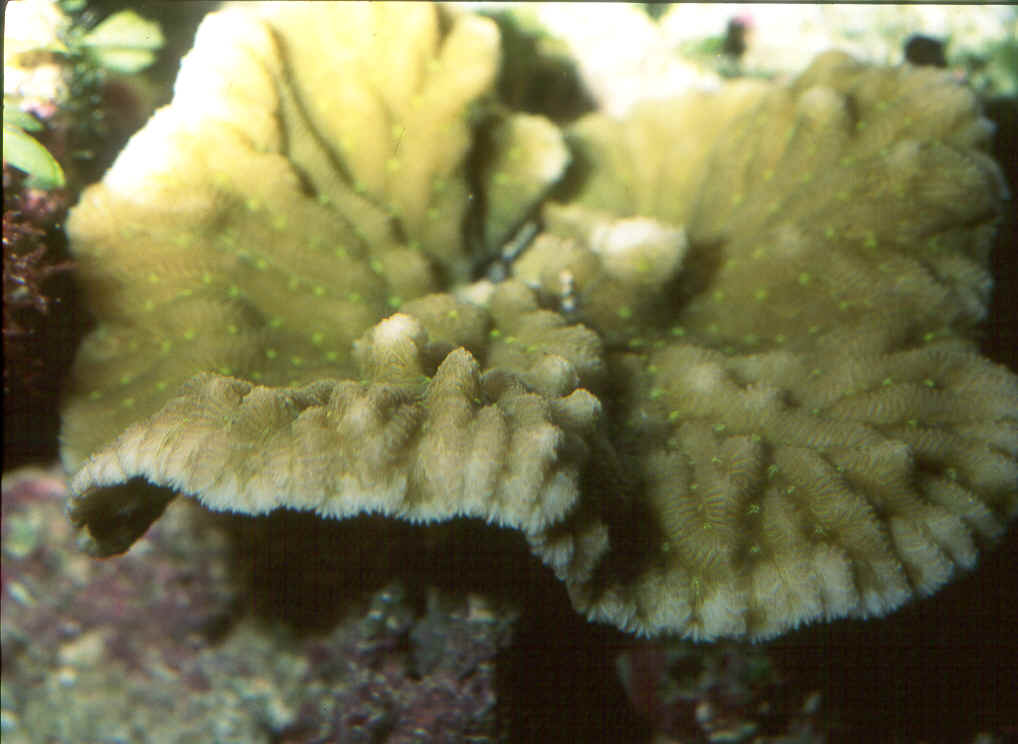
|
|
Re: Receding Chalice Help 2/3/18
Hi Bob, thank you for the prompt reply as always. To update on the situation,
the receding is fairly consistent at the aforementioned rate for now and all
else in the tank appears to be growing. I have began dosing iodine today and
will report back, really hoping to see some some recovery.
Additionally I have moved the Euphyllia as far away as I could.
<Good; all this takes time to show effect>
On another note, the algae that cropped up appears to be the dreaded Bryopsis
(attached).
<Mmm, maybe... this could be a Caulerpacean>
I have been fortunate enough to avoid it until now but the issue seemed to have
welcomed the Bryopsis to take a stroll . None of my cleaners find it palatable
and although I remove what I find manually, it is becoming a concern.
Particularly because it likes to set up shop between my zoa/paly colonies and of
course at the base of the struggling
chalice.
The hydrogen peroxide dip works well, but is appears to really stress out my
zoas too (although eventually almost all of the heads recover). Since I cannot
dip everything in the tank I was desperate for solutions and stumbled upon some
success stories of people using Fluconazole. The results sound promising, and I
was wondering if you had any thoughts on it's use or any other potential
solutions. I'm concerned about raising magnesium to fix it and am making an
effort to further mitigate nutrients.
<I would "try" a bit in a separate, test system, NOT the main display; otherwise
I'd do what you can to favor your purposeful livestock water quality wise and
ignore this weed for now. MUCH more likely negative to occur in treating here>
All the best,
Mike
<And you, Bob Fenner>
|
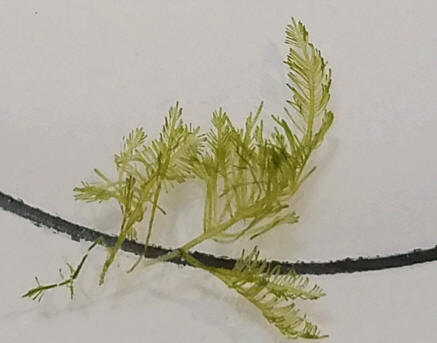 |
|
Re: Receding Chalice Help 2/21/18
Hi Bob,
<Mike!>
So some updates on the situation as well as an interesting/bizarre little
story.
<Ahh!>
The chalice appears to have stopped receding or at least has slowed to a
point where I can no longer tell. It is struggling to grow over the algae
covered skeleton areas but I'm optimistic and some crabs have cleaned it off
a tad.
<Good>
I'd like to think the iodine assisted in the potential recovery but it has
yet to cover the remitted areas in entirety, though has reached past the
skeleton on some small parts. That said, I'm fairly pleased and some updates
regarding the other pieces:
<These issues take time... weeks to months>
The gold torch did not like me moving it and the brown slime took over most
of the remaining heads and ultimately the final head. I tried to save it but
moving it may have resulted in some of the tissue being opened against
it's skeleton as the water flow in the newer area was not in the same
direction. I probably should have been more diligent and shut down the flow
entirely before positioning it, lesson learned.
As for the Bryopsis (Caulerpacean?) I'm not sure if this is Caulerpacean or
not, but the invasiveness and fact that nobody wants to eat it leads me to
lean towards thinking it might be Bryopsis. After mechanically removing it,
it likes to grow as one long stalk that eventually branches out and more
grow at the base. With this pattern and often growing in my Zoa colonies, it
has been a pain in the ass and I'm hoping that I will be able to groom it
into remission with nutrient reduction and mechanical removal, but without
that I'm seriously considering trying the Fluconazole as an alternative if
nothing else works. Are there any creatures I could try that might like the
taste?
<Some snails....>
I've had phenomenal success with emerald crabs for bubble algae and bumble
bee snails for Vermetidae over the years!
Now for the crazy (at least I think so) story. Amazon, in error, sent me
Seachem's "Flourish Excel" instead of the Iodine and being slightly
inebriated and admittedly a total idiot about it, I didn't notice until I
dosed the tank!!! Yikes!
<D'oh!>
I do not run carbon and read that it wouldn't be a big deal but I was
worried it would increase the algae issue I was already having or affect my
inverts/corals. Of course it did, but interesting only two colonies of
Montipora.... Now I have 5 colonies in total at different areas of the tank
(1 rainbow, 3 sunset, 1 reverse sunset). The two largest
colonies are sunset Montis about 3"x5" and 2"x4" sprawling over uneven rock.
The two largest colonies are from the same mother colony and the third
smaller colony I attained by mistake from a dishonest LFS. The two larger
colonies are in totally separate parts of the tank (elevation, flow, and
lighting) and began bleaching the next day. I assumed the bubble tips were
stinging one of them (and moved them), but then noticed it's brother
bleaching as well! Putting two and two together I eventually found a few
posts of people mentioning how activated carbon affected their Monti
colonies and am suspecting that it happened here too. It is very perplexing
because none of the others showed any signs of damage what-so ever including
the other sunset which has the same coloration (but is from a different
mother colony). Within a few days the bleaching and polyp death covered 95%
of both colonies with only a few small living patches remaining with a very
clear demarcation line between the dead (dying?) portions and healthy
tissue. I did some water changes the next few days and am happy to say that
I think they are coloring back up (though the polyps are not there)... then
again it might just be diatoms and algae setting in, but I'm optimistic. Of
course, I also got the actual iodine since and have been dosing that.
<Good>
Additionally when I attained these sickly Montis they were dying and they
recovered in my tank so hoping they can pull through and color back up. I
took some pictures of them at near their worst if you're interested and it
would be the most remarkable recovery and compelling evidence that there
might be a strong link to them and carbon.
<Do please send along>
I also wonder if they are particularly sensitive to it because the hobbyist
that gave them to me may have been running carbon and they developed a
sensitivity. If you have any thoughts on the situation I'd love to hear them
and send another update once I have it.
<Carbon/s are a very big topic, source of issues... there isn't just a one
way fits all, causes trouble with C...>
Thanks again,
Mike
<Welcome. BobF>
|
Re: Receding Chalice Help 3/18/18
Hello Bob,
<Mike>
Sorry for the delay, but here are some pictures of the smaller colony
recovering. These were taken just under two weeks apart from each-other.
They almost fully recovered, but then bleached out again... this time I have no
idea why... now they are recovering again but patchy. Perhaps it is the lack of
stable temperature as of late.
<... how close is that Entacmaea anemone? Trouble>
The chalice is still in limbo. It isn't netting much receding or growth but
appears to have stabilized at least. I'm continuing to dose iodine but in
smaller amounts.
As for the Bryopsis (?), it is doing what it does best: growing quickly.
It is a pain to manually clean it every few weeks and makes maintenance take
much longer than before. You mentioned some snails might not discriminate and
potentially help. Which species of snail do you recommend I take a look at?
<... please see; search, read on WWM re. B>
|
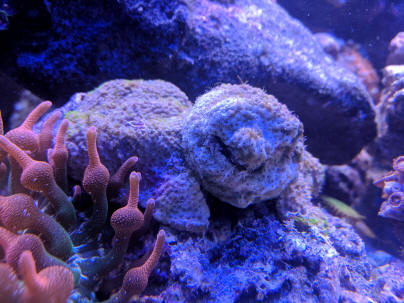 |
|
Re: Receding Chalice Help
This piece is close to the Entacmaea but the other is about two feet away
with the same symptoms.
<Ah; I see. Thank you. B>
|
|
Coral warfare 8/9/15
Hi,
<Lar>
I have a chalice coral, which has grown from about 2 inches across when I
purchased it to about 15 inches across today. Unfortunately, it has grown to the
point where it is overlapping with my Platygyra (about 7 inches across). I am
hard pressed to move either coral as they are both well attached to the rock
work and trying to move them would cause a major
disturbance in the tank.
<... life is.... a series of compromises>
The Platygyra is defending itself and is clearly coming out the winner.
The portion of the chalice that is next to the Platygyra has started dying off
although the rest of the colony seems fine.
<So?>
My inclination is to leave things as they are. The chalice has plenty of room to
grow in other directions and the Platygyra seems to be able to defend itself.
What do you think?
<Can be done... happens "in the wild" "all the time" as we may well presume>
Can I leave it be or do I need to take more decisive actions?
<Can leave... whatever kinds, degrees of chemical and physical warring
(allelopathy) occur, they will habituate amongst the life, system here... likely
w/ small repercussions>
Thanks!
Larry
<Welcome. Bob Fenner>
chalice coral help; need data
4/13/13
Thanks everyone in advance!
<Welcome Kate>
I have scoured the internet, and cannot seem to find information
regarding chalice corals bleaching from non light related
issues.
<There are a few other general "cause" groups... some pathogenic
disease, parasites, lack of nutrient, pollution, allelopathy, other
environmental issues>
I have over 20 chalice colonies in my tank, and bleaching began on one
chalice and has subsequently spread to almost every other chalice in the
tank. Lighting has not been an issue, because the placement of the
corals have not changed in months, and the lighting has remained
consistent.
<Mmm, I'll add "as far as you're aware">
The bleaching spots seem to be random throughout the corals, and do not
cover the entire coral. Besides the bleaching, the chalices have an
extremely swollen appearance, and this is way above the normal inflation
that is seen with healthy corals.
<Useful clues>
The tissue has slightly receded on some of the chalices, but most of the
newly affected ones have absolutely no skeleton showing through, and
just appear extremely puffy and translucent. I have read that
there can be certain bacterial and protozoa infections that can cause
bleaching, but no real information on how to distinguish the causative
agent, or even what treatments to pursue. Any suggestions would be
appreciated.
Kate
<Ahhh, need to know more quantified facts re this system... measures for
PAR/PUR at depth re your light, whatever you measure for water quality;
your maintenance procedures, the presence of other livestock here,
foods/feeding, supplementation practices, the general set up... e.g.
whether you use contactor/s and chemical filtrants, what you have been
doing, not-doing differently the last few weeks... Have you
scanned through the marine disease area on WWM?:
Do so:
http://www.wetwebmedia.com/mardisindex.htm
The second tray down and further.
Bob Fenner>
Re: chalice coral help...
three tanks involved... lack of nutrient, or?
4/15/13
Thanks for your quick reply! I will attempt to give you as much
information as possible. The tricky part is that currently there are 3
systems that are all experiencing the same problem,
<... what is/are the commonality/ies here? The water likely... have you
changed... brands of salt mix, your MO for prep.? Has the municipality
done something overt to your source water... or you to the RO, whatever
treatment you employ?>
and none of them are plumbed together, so I will attempt to give you the
common traits between all of the tanks. As for pur/par, I do not have
exact values or readings (I know, rather useless information on my
part), but the tanks are lit by either metal halide or leds. I have had
bleaching in relation to light before with corals, and the extremely
swollen appearance of the tissue is something I have never seen before.
The tissue on the chalices are so swollen that they look like wellso
brain corals, or other similar corals. One system does have quite a lot
of fish, along with an oversized skimmer and gfo for filtration.
<Remove this... see WWM re "rust" use; the need for appreciable HPO4>
The
other two systems are coral only with live rock, and no fish. I do have
either a diatom or Dinoflagellate outbreak going on in a couple of the
tanks, but not the third one. The dino/diatom (not sure which one and
can't seem to distinguish the two based upon observation alone) is not
covering the whole tank or anything, but I have noticed some of the
slimy brown bubbles here and there, and brown tint to the glass every
few days. I do not know if this is causing the coral problem, but only
the chalices seem to be affected, and I have multiple other lps and soft
corals. Now, you mentioned another possible cause could be allelopathy,
and that did definitely stick out to me. The only real change in my
tanks has been the addition of multiple chalices, not 5 or 10, but
probably 30. I made sure that none of them are actually touching each
other, or that their sweepers are able to touch another coral, but they
are all still in less than 50 gallons of water per tank. I have not run
carbon in at least a year, because I only used it when I saw any nitrate
spike, etc. So is there a possibility that the corals are attacking each
other with their slime or whatever?
<Yes; but in all three separate systems at once? Strange>
Could carbon take care of it?
<Might well help. I would employ this and the product PolyFilter in your
flow path>
If allelopathy is the cause, what are the chances of recovery for the
corals if tank conditions are improved?
<... depends on how badly, how much cascade effect the biochemistry is
eliciting>
Some other little tid-bits of information about tank practices and
changes that have happened in the past month or so would be the addition
of vitamin C tablets (yes, the ones used for human consumption).
<Usually Ascorbic Acid is fine... but just in case, I'd hold off w/ any
further addition>
I heard they were good for corals and fish, so I added a tablet in each
tank one time, and never since then. I also hooked up and used a sulfer
<Sulfur/Sulphur> nitrate reactor on two of my tanks.
<Ahh, this could do it for sure... see WWM re... too much change, even
in the "right direction/s" can have this effect>
I used it for one week on two tanks to try and get rid of the last 5-10
ppm nitrates
<... all chemophotosynthetic life needs "some" NO3... I would NOT reduce
NO3 to zip. SEE/READ on WWM re>
that I had, and then I stopped because I couldn't really find much
information about them, and the whole acidic water thing did kind of
freak me out. Also, I do have chronically low ph, staying around
7.85-7.9.
<... could be the reactor as well... READ re Ozone use, RedOx on WWM...
you're ready>
Granted, the ph has been the same level for 3 years, and I am still
trying to correct that, but I am assuming that is a whole other issue.
Hopefully there is enough information to help with a diagnosis, but if
not, I will try to get any additional information that you may need.
Kate
<... time for you to spend more time reading, understanding, and less
purchasing. B>
Re: chalice coral help 4/16/13
Thank you Bob!
Slow down and read, seems like the best advice for any problems in a
reef tank :-)
<Ah yes... in the meanwhile pull the GFO, stop the Vit. C....>
I will get back to your site and work from there. Hopefully I can figure
something out before I lose my corals; race against time, and taking my
time all for the same problem! Quite the catch-22 Im in right now!
Thanks again!
Katy
<Welcome. BobF>
|
Coral ID...Chalice Coral - 06/23/12
Hi all at WWM,
<<Hey there Simon>>
Could you please identify this coral for me and hopefully point me in
the right direction for some information about it as I'm very interested
in it as it’s just become available to buy. There has been a lot of
discussion about it but no one seems to be able to correctly ID it
locally.
<<Looks to be a “chalice coral” of some kind. Likely a species of
Oxypora or Mycedium. Give those names a search on the NET and see what
you think>>
Thank you once again.
Simon
<<Happy to share… EricR>>
|
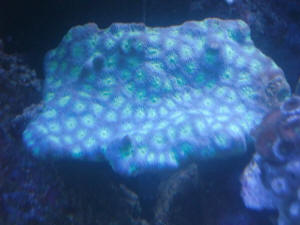 |
|
Coral ID 7/28/10
Hi: I sent this on Saturday (July 24) but it may have been lost
in somewhere in the intertubes. I was hoping you might be able to
confirm the ID of this newly acquired coral. My guess is Pectinia
lactuca from photos in Borneman's book. Do you agree or
disagree?
<I do agree>
I have it medium-low in a 75g under 175w 14000K halides, with
moderate flow. As you can see it's under similar conditions
as the Plerogyra behind it. If it is Pectinia lactuca, this seems
to be what Borneman suggests.
He does not suggest a feeding regimen. Do you have any
suggestions?
<Mmm, well... Pectiniids are Zooxanthellate, to very large
degree dependent on photosynthesis for their nutrition... Keeping
water quality optimized and stable, providing for (and not
totally removing) necessary
macro-chemical nutrients is about the best approach to their
nutrition>
I have fed it Cyclop-eeze and induced its feeding tentacles to
emerge.
<Additionally they all do feed at night with long,
near-transparent tentacles. Some aquarists do, some don't...
feed theirs that is. These corals are at their best being offered
some fine-particulate meaty foods on an occasional basis. Bob
Fenner>
Thanks for your time!
Ed
|
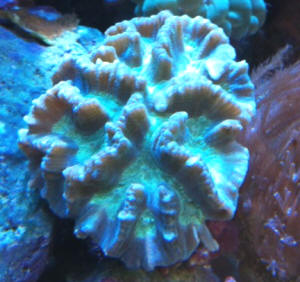 |
Chalice has become completely different color than when
purchased... -- 11/12/09
Dear WWM Crew,
<Laura>
Hope all is well with you guys tonight!
<Thank you, yawn (!); now the AM and am trying to improve
awareness... Patterning in>
I have an 85 gallon reef with the following water/lighting
parameters:
Temp: 78F
Ph: 8.2
Alk: 9 dKH
Calcium: 440
Nitrates: <5 always, but mostly undetectable
Phosphates: 0
Magnesium: 1380
Add 2 drops Lugol's solution weekly
10% water change weekly with Tropic Marin Pro Reef salt mix.
Lighting is one 150w 14,000k HQI double ended Hamilton Metal Halide
bulb with 2 96W VHO lights - one super actinic.
Tank has a refugium with Chaetomorpha.
<So far, so good>
A couple of months ago, I bought a "designer" Emerald Mummy
Eyed Echinophyllia Chalice coral via a very reputable mail order house.
The coral was healthy (and emerald with red eyes!) when it arrived. It
struggled in my tank for several weeks, and showed some signs of
recession in a few spots along the edges. I thought I had acclimated
well, but the coral seemed stressed for the first month or so. After
moving it around a bit, it has finally settled in well on the bottom of
my tank, towards the center in the front.
I have it on a flat piece of live rock to avoid the tissue settling
into the sand and irritating the coral.
<Good>
The recession appears to have halted, the tissue is now nice and puffy,
and the coral really appears to be stable and on the mend. But the
problem is, this coral now looks nothing like what I purchased! The
eyes are still bright red, but the surrounding tissue is no longer
emerald. It is a brick red or almost a muddy brown in color. I know I
moved the coral around initially to find the spot is seemed to respond
to best, but could this have caused the color change?
<Mmm, just being moved about, shipped... new conditions. It may well
improve with time, good care>
And, is the color change permanent?
<How to put this? The only permanence is change as the saying sort
of goes.
The short answer: "No, not permanent". Can change>
I did call the store where it was ordered from to inquire what their
lighting was for this animal. It was MH lighting although I cannot
remember the Kelvin rating on it - I think it was 20K.
<Mmm, surprising. Most culture facilities, folks in the trade, keep
these/Scleractinians under 12-14K lighting>
I have been hoping that over time, as the coral continues to adjust and
recover, it will color morph again, as these corals so often do. Please
let me know your thoughts. I am not 100% happy with the color of the
piece now.
<Time>
On another note, a little over a week ago, I got a beautiful gold
chalice that I have in the lower middle of the tank. It was drip
acclimated for two hours. It looks very healthy - no bleaching or
recession, but the tissue has not really expanded fully. It is not
puffy and full looking. Do you feel this coral is still acclimating to
its environment, or that this is a sign of stress I need to
address?
<Likely mostly acclimation>
Thanks in advance for the response!
Laura Rothbaum
<Do you feed these stony corals? Please see the Net re Pectiniid
nutrition.
Bob Fenner>
Re: Chalice has become completely different color than when
purchased... -- 11/12/09
Hi Bob,
<Laura>
Thanks so much for your reply.
<Welcome>
Yes, I target feed these corals 3 times a week with a mixture of
phytoplankton and Cyclopeeze. I know the phyto is too small for them,
but I use it as a "base" to put the Cyclopeeze in and target
feed the entire tank every other day with the pump/skimmer off for
about 30 minutes.
<Good practice>
I can visibly see the chalices taking in the Cyclopeeze. If you have
any other preferred food sources for these guys, let me know.
Laura
<You may have just tipped my balance in getting off my duff and
compiling notes into a mini-omnibus on Cnidarian
foods/feeding/nutrition. There is much to say, state plainly... among
other things to dispel the notion that feeding phytoplankton is of
value. BobF>
Re: Chalice has become completely different color than when
purchased... 11/13/09
Hi Bob,
<Friend Laura>
If I have played any role in you writing on the subject, I am glad, as
I voraciously read anything I can find that you have written!
One of the things about the hobby that is so frustrating is the
conflicting information one finds on any given subject.
<Ah yes... the a priori "cause" (promulgation) for my and
friends developing WWM... As you will appreciate, knowing summat about
a field, and prizing its place in human affairs, the Net is (presently)
the best route for "making what is important known"...
Unfortunately it is just as readily a vehicle for mis and
dis-information>
If there is anything you can do to clarify that (i.e. feeding
phytoplankton to corals is or isn't of great value), please do! We
try so hard to do what is best for our animals, and would like to think
the information we are relying on is accurate.
Thanks again,
Laura
<And significant, meaningful... Have put this writing project on my
A list. Cheers, BobF>
|
Help with coral ID -- 08/14/09
Hi Bob,
<Chris>
A friend gave me the coral in the attached pic, but I am having a
Dickens of a time ID'ing it. I'd appreciate any help
(family, genera, etc) that you all can provide.
Best,
Chris
<A Pectiniid of some sort:
http://wetwebmedia.com/pectiniids.htm
BobF>
|
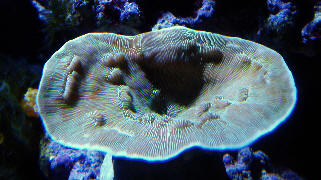 |
|
Echinophyllia... allelopathy? -- 03/22/09
Hello,
<Cassidy>
I have an Echinophyllia (spelling?)
<Correct>
chalice coral. I've had it for about a year now and was doing
wonderful until recently. Nothing that I am aware of has changed
aside from switching out lamps about two months ago. I have
noticed these tiny little worm type things protruding from it
when I feed the corals and the pump is off.
Otherwise it looks normal. My other chalices do not seem to have
these worm type filaments coming off them. They are white very
slender and at first I thought they may be sweeper tentacles but
have since reconsidered. I took a turkey baster and attempted to
blow them off but they don't budge.
<Mmmm... maybe hydrozoans>
So since then I cut a small piece off the coral and there were
tons and tons of them. literally hundreds. I have tried to find
any recourse about pests that will only bother echinos but no
luck. On a side note I have 4
other full colonies of chalice and none of them display these. I
have both aspera, Oxypora, and lilyphytons (spelling?).
<Mmm, all but this last>
I tried to take some photos of this but my camera is terrible. I
have attached a pic of the best quality I am able to provide.
Also a Tank shot so you can see everything else is
thriving...
Tank parameters are SG 1.023
<I'd raise this... 1.025-1.026>
phosphate nitrite nitrate are all very low. CA at 420-450 DKH 9
Temp is between 76 and can get up to 80 some days. 300 Gallons +
40 w/ sump.
heavily stocked running de-nitrate, Phosban,
<And not use these chemical filtrants. See WWM re>
and carbon sometimes. 40 gallon water changes bi monthly. I have
been adding Probio biotpim and bio clean also in an effort to get
the phosphates to .03
<Good... and/but at cross purposes with the Phosphate
remover>
I would appreciate any help.
Thank You,
Cassidy
<I would improve the environment here... and not try a
biological "cleaner". Bob Fenner>
|
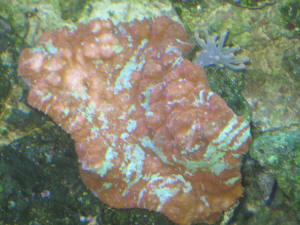 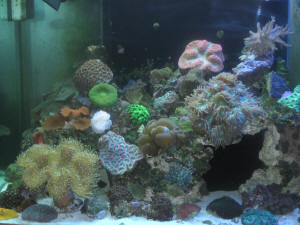 |
|
Re: Echinophyllia...
allelopathy? 3/23/09
Bob,
<Cassidy>
Thanks for the relay. I went and looked at every picture of
hydrozoans I could find.. and these do not compare to what I
have. They look like worms and you cannot make out a head or any
legs on their slender bodies.
<Okay... a close-up pic or two would be nice if you could send
along.>
They are white with a slightly off color line down them. They are
about 5/8" to 1/2" long and all come out at once of the
mouth of the Echino.
<? The mouth? You mean the individual polyps?>
I am not sure if they are indeed the feeding tentacles??? I'd
be happy to mail a piece of the coral to you if you want a
sample...? then you could see for your self.
Thanks,
Cassidy
<Mmm, not practical... am out diving in a couple days. Try a
large size file with the best macro lens on your digital
camera... and spiffing this up. Bob Fenner>
Re: Echinophyllia... allelopathy?
3/23//09
My camera isn't too great. What do you mean improve the over
all quality of the environment? More water changes to get things
low instead of using filter media? I was under the impression
that changing large qty
of water causes a 'shock' to the whole tank every time we
do that... Or is it better to change 40G like every weekend if
time permits?
Also the SG of 1.025 or 1.026 can be done.. Should that be a
permanent change or just for a while..? Everything I've been
told (probably incorrectly) was to keep it at 1.023-1.024 but
1.025 is the highest possible it should ever be.
Thanks,
Cassidy
<These issues are covered on WWM... please avail yourself of
the search tool, indices. B
|
Can You Please Help Me Identify This Coral?
03/22/08 Dear Sir or Madam, We purchased this beautiful coral
from a local merchant and was told by one employee that it was a
Blastomussa and by another that it was a Pavona. <Haha, wow,
that's quite a difference of opinion! It is not either of
these.> Both of which to us it does not look like. Can you
please tell us what it is? <It's impossible to accurately ID
without a close look at the exposed skeleton, but it looks like a
Pectinia sp. to me. http://www.wetwebmedia.com/pectiniids.htm>
Best regards,
Marc & Belinda Barry
<Best,
Sara M.> |
|
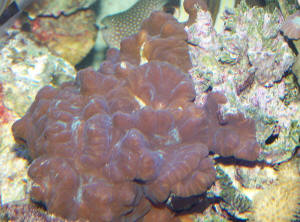
|
Coral Identification... Echinophyllia
12/28/2007 Hello Crew <Hi Claire, Mich here asking
forgiveness in my tardy reply.> I was wondering whether you
would be able to identify this coral for me. <Is hard with just
a photo... but I will certainly try.> I was thinking either
Oxymora lacera, or Echinophyllia aspera ... or I could be
completely wrong and it is something totally different? <I think
it may be an Echinophyllia. The corallites in Echinophyllia
typically occur at many different angles and are often raised and
bumpy. The corallites in Oxymora are generally more patterned and
regular.> Thanks for any help you can give me. <Hope this
helps! Mich>
Claire |
|
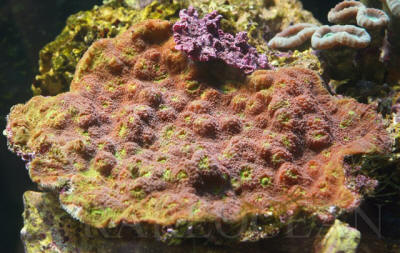
|
| Candy Cane... Uh, no... and other nonsense from
not reading WWM 7/10/07 Hi Crew, The attached was
sold to me as a candy cane. It does not look like my other candy
canes which have branches. Is it a Favia? <Mmm, no... wrong
family... But right Class! Please read here:
http://www.wetwebmedia.com/pectiniids.htm> Recently I got some
corals from 3 different people and put them in my tank. Now there
is ick. <...> First my neon gobies got it and my clown goby.
I removed them and treated with copper but the neons died.
>...< The clown looked very bad but now is clear and is
eating. I still have a Gramma in the display and a cardinal. The
Gramma has it and I did not catch it yet. <The last is the
operative word> But he is still eating. The cardinal is still
clean. I understand that if I do not remove all then they are
hosts. <Bingo, double Bingo today!> But if the cardinal does
not get it and the others recover and I do not remove the cardinal
will the clown and Gramma get it as soon as I return them to the
display or will they have gotten immune? Thanks <... Drizzard,
drazzard, drizzerd drone, time for this one to read... See WWM re
all this... the indices, search tool. Bob Fenner> |
|
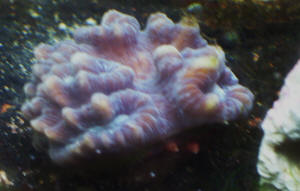
|
Echinophyllia care, Berghia Nudibranch in main display -
09/03/06 Hello once again. I have a couple
of questions for you. I recently purchased a 3" purple
and red Echinophyllia which I had researched before the purchase, and
believe needs to be placed in bright light with moderate flow, correct?
<Mmm, within defined terms. Please see here: http://www.google.com/custom?domains=www.WetWebMedia.com&q=echinophyllia&sitesearch=www.WetWebMedia.com&client=pub-4522959445250520&forid=1&ie=ISO-8859-1&oe=ISO-8859-1&cof=GALT%3A%23008000%3BGL%3A1%3BDIV%3A%23336699%3BVLC%3A663399%3BAH%3Acenter%3BBGC%3A99C9FF%3BLBGC%3A336699%3BALC%3A0000FF%3BLC%3A0000FF%3BT%3A000000%3BGFNT%3A0000FF%3BGIMP%3A0000FF%3BFORID%3A1%3B&hl=en>
The coral appears to look the same day and night, which doesn't
seem right to me ( doesn't seem to "swell up" during the
day). I don't have a picture of the coral but it looks
like a plating variety, similar to a plating Montipora with more
"bumps". I have it about 12" under water
directly beneath a 250 watt metal halide light. Is this too
much light? <... Mmm, you state you "recently"
acquired this colony/animal... takes a while to adapt (weeks...)...
shouldn't be exposed to much more light than it was... See WWM re
photo-acclimation of Scleractinians> My
other question is, on the website www.saltyunderground.com it says you
can put Berghia Nudibranchs directly into your main display which
conflicts with other things I've read. They suggest 8
per 100 gallons. I have plenty of Aiptasia, what do you
think of this idea? <Is done "all the time"> I have a
clown fish, blue flavivertex Pseudochromis, Kole tang, cleaner shrimp
and a bubble tip anemone. <Not a good idea to mix with stony, soft
corals...> My thought was that by adding 8 to my tank a couple would
hopefully survive long enough to reproduce and get rid of the Aiptasia.
<"So many foxes, so many rabbits"...> I know the
Aiptasia are a result of too many nutrients in the water but I do a 10
percent weekly water change and feed corals and fish lightly, and
don't know what else to do to keep them from reproducing (remora
pro protein skimmer). <... see WWM re> I have a 90
gallon tank with a 20 gallon overflow, would a bigger protein skimmer
help...what would you suggest? <That you read>
Euro-reef models seem to be getting cheaper and I was
thinking about getting a RS model rated for 135 gallons. All
my tests read 0 for anything bad, but believe this is a result of my
"Aiptasia filter". <You are wise here> Would adding
some macro algae help compete for nutrients? <Mmm, yes> I guess
that was more than a couple questions. Thanks for your help
and your website, Ryan. <Keep using it. Bob Fenner>
Pectinia sp. slime 7/10/05 Thanks for fielding my question.
<Welcome> Recently, my Pectinia coral experienced some
shock. It fell from it's perch midway up my 140gal tank
(28" tall), mixed tank 2x400MH and 2x 110w VHO, all other tank
parameters are perfect. I moved it to a new place, because I
could not get it to stay in it's original place. Some of
the internal skeleton was showing from where pieces broke
off. Some of the damaged began to slime... a
lot. And now the slime has covered a lot of the rock with
bubbles attached to the slime streamers. None of my other
coral are declining because of this, but it looks like I have a serious
case of Cyanobacteria, which I do not think it is. I have
had that before!!! I have been sucking the slime off the rocks while
doing small water changes all week and plowing the slime off the rocks
every night, so my skimmer can do some of the work. My
protein skimmer is running full time and skimming dark green
waste. New carbon in the sump. It looks like my Pectinia is
recovering after a week of this. It is a beautiful coral
under actinic lights. Is there any thing else that I should
be doing? thanks you for your time. cde <I would check your
alkalinity, calcium levels, bolster if low, add the activated carbon to
your filter flow path... and dose with an iodide solution. Bob
Fenner>
Pectinia paeonia propagation 6/29/05 Mr. Fenner: I love your
website, it is a tremendous resource. I was hoping to get either
Anthony Calfo, or Eric Borneman's opinion on the possibilities of
fragging Pectinia Paeonia. <Anthony here with bells on... earring
too... a tight lil purple dress. Its a good day.> I have read your
page on the Pectiniids, and realize that there is little demand, and a
slow growth rate for these corals. But is it possible to propagate
these the same way as SPS fragmentation?? i.e., breaking
into smaller pieces and supergluing them to "plugs"?
<Yes... similar> Or does this coral require an LPS method where
the skeleton must be cut, and the tissue allowed to grow apart? <Not
at all... the latter being too slow/conservative> My concern arises
with the mouth shaped orifice located deep within the flutes of the
coral... Thank you. Ben Ward <Pectinia can simply be sawn without
care or caution to include a mouth with every frag. Use a masonry saw
blade... preferably a wet saw (cooling the blade... less tissue
damage). Cheap DIY tile cutting saws work fine here. Just rip into fast
clean sections. We just did a fab demonstration of this at IMAC. Go to
theimac.org and you will see DVDs of it for sale in a few weeks (cheap
too). Maintain good water flow on the divisions... and be sure to make
lateral or lower moves, but not higher, when returning the frags to the
tank. Best of luck! Anthony>
|
|

